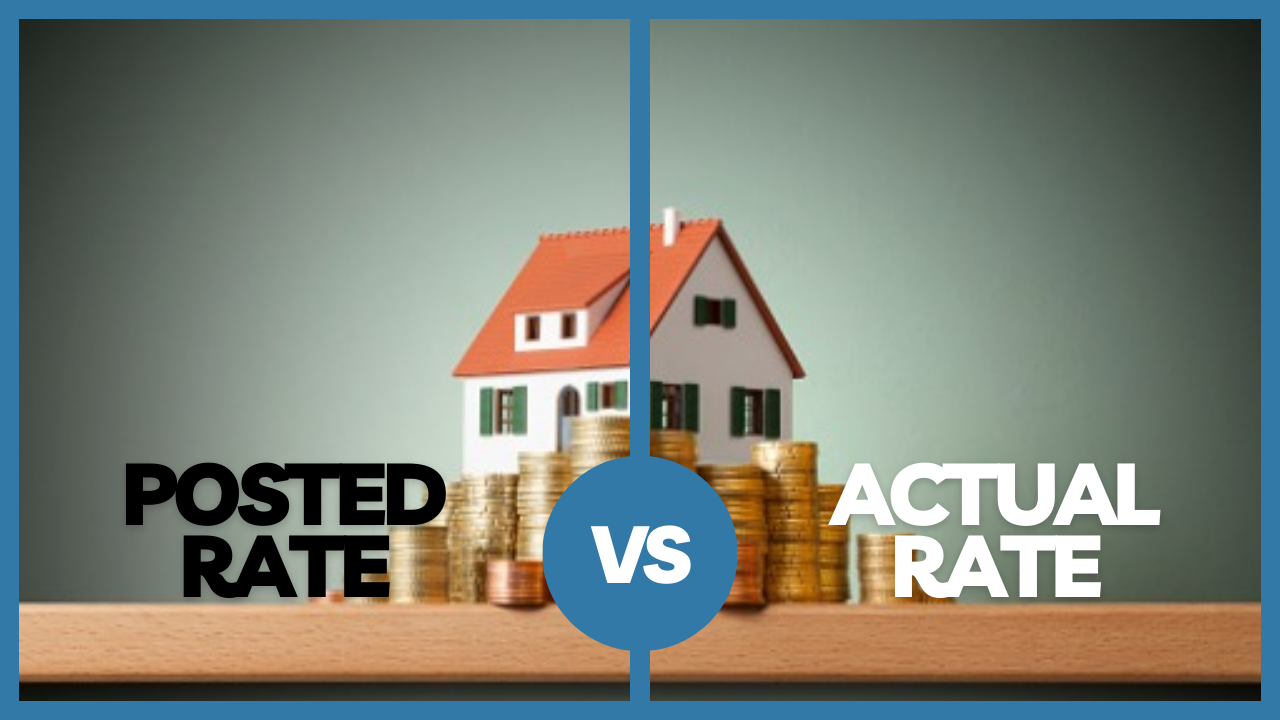Posted Rates And Actual Rates
As a Canadian looking to buy a home or refinance an existing mortgage, you may have heard the terms “posted rate” and “actual rate.” These are two critical terms that you need to understand before getting a mortgage in Canada. Understanding the difference between posted rates and actual rates can help you save money and make informed decisions. In this blog post, we’ll explain the difference between posted rates and actual rates and how they impact your mortgage.
Posted Rates
A posted rate is the rate advertised by a lender or bank to the public. It is the rate that appears on the lender’s website, on their marketing materials, and in their branches. Posted rates are typically higher than the actual rates offered to borrowers. The posted rate is used as a benchmark to calculate the lender’s discounted rate, which is the actual rate offered to borrowers.
Lenders use posted rates as a marketing tool to attract customers. The posted rate is often higher than the actual rate to give the impression of a discount when a borrower negotiates a lower rate. The posted rate is also used as a benchmark for determining the penalty fee for breaking a mortgage contract.
Actual Rates
Actual rates are the rates offered to borrowers. They are typically lower than the posted rates and are negotiated based on the borrower’s credit score, income, and the size of the down payment. Actual rates can be fixed or variable and can have different terms and conditions, depending on the lender.
Actual rates are not advertised and are only available to borrowers who have applied for a mortgage. The actual rate is based on the borrower’s financial situation, the loan-to-value ratio, and the lender’s policies.
Difference Between Posted Rates and Actual Rates
The difference between posted rates and actual rates is significant. Posted rates are used as a marketing tool to attract customers, while actual rates are the rates offered to borrowers. Posted rates are often higher than actual rates and are used as a benchmark for determining the penalty fee for breaking a mortgage contract.
When a borrower negotiates a mortgage, they will often negotiate a rate that is lower than the posted rate. The actual rate is based on the borrower’s credit score, income, and the size of the down payment. The lender will also consider the loan-to-value ratio and the property’s location and condition.
Why Posted Rates are Higher?
Lenders use posted rates as a marketing tool to attract customers. The posted rate is higher than the actual rate to give the impression of a discount when a borrower negotiates a lower rate. This is similar to how retailers use “regular price” and “sale price” to make customers feel like they are getting a deal.
Posted rates are also higher to protect the lender’s profit margin. Lenders borrow money from investors to fund mortgages and pay interest on the borrowed money. The posted rate is higher than the actual rate to ensure that the lender makes a profit on the difference between the posted rate and the rate paid to investors.
Why Actual Rates are Lower?
Actual rates are lower than posted rates because they are based on the borrower’s credit score, income, and the size of the down payment. The lender will also consider the loan-to-value ratio and the property’s location and condition. The lower the risk to the lender, the lower the rate offered to the borrower.
Actual rates can also be influenced by market conditions. When interest rates are low, lenders may offer lower rates to attract borrowers. Similarly, when interest rates are high, lenders may offer higher rates to offset their borrowing costs.
How to Get the Best Mortgage Rate?
To get the best mortgage rate, you need to do your research and shop around. Start by comparing posted rates from different lenders to get an idea of the market. Then, apply for pre-approval from several lenders to get actual rates based on your financial situation.
When negotiating a mortgage, keep in mind that the posted rate is not the actual rate offered to borrowers. Use the posted rate as a starting point for negotiations and aim for a rate that is lower than the posted rate.
You should also consider working with a mortgage broker to help you find the best rate. Mortgage brokers work with multiple lenders and can offer you a range of options. They can also negotiate on your behalf to get you the best rate and terms.
It’s important to note that getting the best rate isn’t always the most important factor when choosing a mortgage. You should also consider the terms and conditions of the mortgage, such as the amortization period, prepayment privileges, and penalties for breaking the mortgage contract.
Freedom Capital
At Freedom Capital, we understand that getting a mortgage can be overwhelming. That’s why we offer personalized service and competitive rates to help you find the right mortgage for your needs.
We offer a range of mortgage options, including fixed-rate and variable-rate mortgages, as well as options for first-time homebuyers, self-employed mortgage borrowers, and those with unique financing needs.
If you’re looking for a mortgage, contact us today to schedule a consultation. Our experienced team will work with you to find the best mortgage option for your financial situation and help you navigate the mortgage process.
In conclusion, understanding the difference between posted rates and actual rates is essential for anyone looking to buy a home or refinance their mortgage. Posted rates are a marketing tool used by lenders to attract customers, while actual rates are based on the borrower’s financial situation and the lender’s policies. To get the best mortgage rate, you need to do your research, negotiate with lenders, and consider working with a mortgage broker. And if you’re looking for a mortgage in Canada, be sure to consider Freedom Capital for competitive rates and personalized service.








